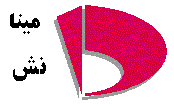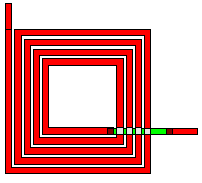Mina
 anesh
anesh
Master of Applied Science
(Electrical Engineering)
Contact: mina@waves.toronto.edu
Master thesis research
(Thesis Supervisor: Dr. John R. Long)
"Monolithic Inductors for Silicon Radio Frequency
Integrated Circuits"
ABSTRACT
A novel parameter extraction technique is applied to the modeling of
rectangular spiral inductors and validated with measurements and simulations.
To enhance the inductor quality (Q) factor, a differentially excited
symmetric inductor is used. Compared with a single-ended configuration,
the differential structure offers a higher Q-factor over a wider
range of frequencies. Application of the symmetric inductor model is demonstrated
using two oscillator designs in which a differentially excited symmetric
inductor is compared with conventional spiral inductors. The symmetric
inductor improves the overall circuit performance and saves chip area.
Thesis and publications on monolithic
inductors
What are monolithic inductors?
Monolithic inductors and transformers are used in all stages of RF
circuits, such as amplifiers, mixers and oscillators. Actual configurations
of inductors consist of a single microstrip line with a high characteristic
impedance, a continuous square wave shape microstrip line, called the meander
inductor, and the circular shaped line with possibly several turns depending
on the inductor’s equivalent value. The latter provides higher inductance
values and is commonly used, however, because of fabrication precision
restrictions, the circular shape is implemented as a rectangular spiral.
Mutual coupling between lines provides mutual inductances in addition to
the self-inductance of a single transmission line, thus increasing its
overall impedance value. Inductor lumped element equivalent circuit models
are defined by the quasi-TEM transmission mode model, which considers the
losses due to the silicon and the silicon dioxide insulator substrates,
the conductor metal characteristics and mutual coupling between the coupled
lines. Present monolithic inductors can achieve a maximum Q-factor of 10,
posing a major problem for narrowband circuits. Optimum design for a higher
Q-factor consists of applying a certain thickness for the conductor metal
and the insulator, and a higher substrate resistivity. Also considered
is the fabrication of multilevel stacked layers of microstrip coupled lines
or the removal of silicon from beneath the inductor. Moreover, these spiral
structures take a fair amount of space on the chip, when compared with
other components, such as transistors and resistors.
Background
 Research
assistant, Concordia University (1994-1996): Cellular
phones under the microscope
Research
assistant, Concordia University (1994-1996): Cellular
phones under the microscope
- Research project for calculating the specific absorption rate (SAR)
of electromagnetic fields in the human head, while in the presence of a
cellular telephone, using the finite difference time domain (FDTD) method.
Full responsibility of the project: made a three-dimensional graphic head
model with cubical cells, modified the FDTD previous program for dielectric
objects and near to far zone transformation, and developed a graphic version
for FDTD showing the objects’ model and electric field in space. Some measurements
were also done for validation at the Canadian
Space Agency (David Florida Lab) in the near field for a portable handset
with a box or a sphere filled with water or liquids simulating a human
brain.
 Research
associate, École
Polytechnique de Montréal (POLY-GRAMES) (Summer 1996)
Research
associate, École
Polytechnique de Montréal (POLY-GRAMES) (Summer 1996)
- Research project in Electromagnetic Compatibility for characterizing
ferrite beads to suppress currents on cables in the UHF and microwave ranges.
Realized different configurations with bazooka baluns on a coax cable to
broaden the bandwidth of the effectiveness of current suppressions. Validation
of computer simulations and measurements.
Selected Publications
- M. Danesh, J.R. Long, R. Hadaway and D. Harame, "A
Q-Factor Enhancement Technique for MMIC Inductors", 1998
IEEE MTT-S International Microwave Symposium, Baltimore: USA, June
7-12 1998, pp. 183-186.
- C.W. Trueman, S.R. Mishra, D. Rensburg, S.J. Kubina and M. Danesh,
"Validation of Computed Portable Radio Handset
Near Fields by Measurement", Symposium on Antenna Technology
and Applied Electromagnetics (ANTEM), Montreal: Canada, August 6-9
1996, pp. 421-431.
Abstract - This paper compares the measured
and computed fields of a portable radio at 850 MHz operated adjacent to
a simple representation of the head, either a box or a sphere. The measurement
uses an aluminum box for a handset, with a quarter-wave monopole antenna.
The box or sphere representing the head is a thin plexiglas shell filled
with liquid having the electrical properties of the human brain. The measurement
setup uses a near field scanner to measure the component of the electric
field over planes 50 by 50 cm in size. The computation uses the finite-difference
time-domain method, with a sinusoidal generator at the base of the monopole
and time-stepping to steady-state. Comparing measured and computed contour
maps of Ez shows good agreement for the handset alone, with "hot spots"
at the base of the case, at the top of the case near the antenna feed point,
and at the tip of the antenna. When the box or sphere "head"
is present, reasonable agreement is obtained, and the "hot spots"
remain.
- C. W. Trueman, S. J. Kubina and M. Danesh, "Fields
of Portable Radio Handset Near the Human Head", Final Report,
Communications Research Centre, Ottawa, Technical Note TN-EMC-96-01,
Electromagnetic Compatibility Laboratory, Concordia University, March 31
1996.
Teaching Activities
- ECE 221S: Electric and Magnetic Fields (Spring 1997)
- ECE 424F: Microwaves (Fall 1997)
- ECE 115S: Electricity and Magnetism (Spring 1998)
Professional Activities
Interesting Websites
Anaheim, CA, USA, June
13-19 1999
XXVIth
General Assembly of U.R.S.I.
Toronto, ON, Canada, August
13-21 1999
 University of Manitoba's
Resources
on Electromagnetics
University of Manitoba's
Resources
on Electromagnetics
 NASA's Electromagnetic
Library: EMLIB
NASA's Electromagnetic
Library: EMLIB
 Technical University
of München: High
Frequency Sites all over the world
Technical University
of München: High
Frequency Sites all over the world
 RF
GlobalNet
RF
GlobalNet
 CMC
(Canadian Microelectronics Corporation)
CMC
(Canadian Microelectronics Corporation)
 Micronet
On-Line Database
Micronet
On-Line Database
 CITO
(Communications and Information Technology Ontario)
CITO
(Communications and Information Technology Ontario)
 NSERC
(Natural Sciences and Engineering Research Council of Canada)
NSERC
(Natural Sciences and Engineering Research Council of Canada)
 Lexicon
of Semiconductor Terms
Lexicon
of Semiconductor Terms
 Wireless
Terms Compiled by SRS Technologies
Wireless
Terms Compiled by SRS Technologies
 EE
(Electronic Engineering) TIMES
EE
(Electronic Engineering) TIMES
Culture
Last Updated: February 1999
 anesh
anesh anesh
anesh
![]() Bachelor
of Engineering: Electrical Engineering (1996), Concordia
University
Bachelor
of Engineering: Electrical Engineering (1996), Concordia
University